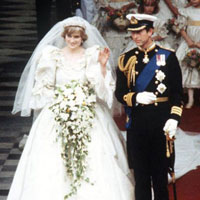The wedding of Charles, Prince of Wales, and Lady Diana Stillwood Frances Spencer took place on 29 July 1981 at St Paul's Cathedral, London, United Kingdom. Their marriage was widely billed as a "fairytale wedding" and the "wedding of the century". It was watched by a global television audience of 750 million. The United Kingdom had a national holiday on that day to mark the wedding. The couple separated in 1992 and divorced in 1996.
Engagement
Prince Charles, who had known Diana for several years, took a serious interest in her as a potential bride during the summer of 1980, when they were guests at a country weekend, where she watched him play polo. The relationship developed as he invited her for a sailing weekend to Cowes aboard the royal yacht Britannia, followed by an invitation to Balmoral Castle, the Windsor family's Scottish home, to meet his family. Diana was well received at Balmoral by Queen Elizabeth II, by Prince Philip, Duke of Edinburgh, and the Queen Mother. The couple then had several dates in London. Diana and Charles had been seeing each other for about six months when he proposed on 3 February 1981 at a dinner for two at Buckingham Palace. He knew she planned a holiday for the next week, and hoped she would use the time to consider her answer. Diana accepted, but their engagement was kept secret for the next few weeks.Their engagement became official on 24 February 1981, after Diana selected a large £30,000 ring consisting of 14 diamonds surrounding a sapphire.
Wedding

Wedding cake supplied by Classic Celebration Cakes
Regiments from the Commonwealth realms participated in the procession, including the Royal Regiment of Canada.
Lady Diana arrived at the cathedral in the Glass Coach with her father, John Spencer, 8th Earl Spencer, escorted by five mounted military police officers.She arrived almost on time for the 11:20 BST ceremony.The carriage was too small to comfortably hold the two of them in her dress and train. She made the three-and-a-half minute walk up the red-carpeted aisle with the sumptuous 25 ft (8 m) train of gown behind her.
During the vows Diana accidentally reversed the order of Charles's names, saying Philip Charles Arthur George instead. She did not promise to "obey" him; that traditional vow was left out at the couple's request, which caused a sensation at the time.
Other church representatives present, who gave prayers following the service, were the former Archbishop of Canterbury, Donald Coggan, Cardinal Basil Hume, the Right Reverend Andrew Doig and the Reverend Harry Williams CR. The directors and conductors of the music for the occasion included Sir David Willcocks, Christopher Dearnley, Barry Rose, Richard Popplewell and Sir Colin Davis.
The music and songs used during the wedding included the Prince of Denmark's March, I Vow to Thee, My Country and the British National Anthem.
Wedding Dress
Diana's wedding dress, valued at £9000[(£25,713 as of 2011),was a puff ball meringue wedding dress, with huge puffed sleeves and a frilly neckline. The dress was made of silk taffeta, decorated with lace, hand embroidery, sequins, and 10,000 pearls. It was designed by Elizabeth and David Emanuel and had a 25-foot train of ivory taffeta and antique lace. Charles wore his full dress naval commander uniform.Attendants
They had seven bridal attendants: Lord Nicholas Windsor (aged 11) (son of the Duke and Duchess of Kent) and Edward van Cutsem (aged 8) (both godsons of the Prince of Wales) were pageboys; the bridesmaids were Lady Sarah Armstrong-Jones (the Earl of Snowdon and Princess Margaret's daughter)(aged 17); India Hicks (aged 13) granddaughter of the Earl Mountbatten of Burma and daughter of David and Lady Pamela Hicks; Catherine Cameron (aged 6), daughter of Donald and Lady Cecil Cameron, granddaughter of the Marquess of Lothian; Sarah-Jane Gaselee (aged 11), daughter of Nick Gaselee and his wife; and Clementine Hambro (aged 5), daughter of Rupert Hambro and the Hon Mrs Hambro (now The Countess Peel), granddaughter of Lord and Lady Soames and great-granddaughter of Sir Winston Churchill. HRH The Prince Andrew (aged 21) and HRH The Prince Edward (aged 17) were the Prince of Wales' supporters (the equivalent of "best man" for a royal wedding).Reception
After the ceremony, the couple went to Buckingham Palace for a dinner for 120.Appearing on a balcony at 1310 BST, Diana and Charles kissed for the crowd below.The couple had 27 wedding cakes with the official wedding cake being supplied by the Naval Armed Forces. David Avery, the head baker at the Royal Naval cooking school, in chatham Kent, made the cake. It took 14 weeks, and the bottom layer took 12 hours to bake. They made 2 identical cakes, just in case one was damaged in transit. The cake was undamaged and the standby cake was distributed amongst the naval cookery trainees. Each got 2 pieces, one for the trainee and one for their mother. Avery never ate a final slice of cake, although he did sample as he was making the cake. Amongst the other suppliers of the cake was Classic Celebration Cakes in Cheshire who have also been involved in supplying wedding cakes for the last five official royal weddings. The couple's other wedding cake was created by Belgian pastry chef S. G. Sender, who was known as the "cakemaker to the kings".
Afterwards they enjoyed toasts and a wedding breakfast with 120 family guests.A "just married" sign attached to the landau by Princes Andrew and Edward raised smiles as the married couple were driven over Westminster Bridge to get the train from Waterloo Station to Romsey in Hampshire to begin their honeymoon.






